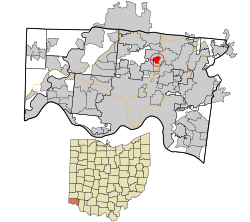Lincoln Heights, Ohio
| Lincoln Heights, Ohio | |
|---|---|
| Village | |

Houses on Steffen Avenue
|
|
 Location in Hamilton County and the state of Ohio. |
|
| Coordinates: 39°14′41″N 84°27′20″W / 39.24472°N 84.45556°WCoordinates: 39°14′41″N 84°27′20″W / 39.24472°N 84.45556°W | |
| Country | United States |
| State | Ohio |
| County | Hamilton |
| Area | |
| • Total | 0.76 sq mi (1.97 km2) |
| • Land | 0.76 sq mi (1.97 km2) |
| • Water | 0 sq mi (0 km2) |
| Elevation | 594 ft (181 m) |
| Population (2010) | |
| • Total | 3,286 |
| • Estimate (2012) | 3,366 |
| • Density | 4,323.7/sq mi (1,669.4/km2) |
| Time zone | Eastern (EST) (UTC-5) |
| • Summer (DST) | EDT (UTC-4) |
| ZIP code | 45215 |
| Area code(s) | 513 |
| FIPS code | 39-43722 |
| GNIS feature ID | 1048919 |
| Website | www |
Lincoln Heights is a village in Hamilton County, Ohio, United States. The population was 3,286 at the 2010 census. It is a suburb of Cincinnati.
Lincoln Heights was founded in the 1920s by property developers as a suburban enclave for black homeowners working in nearby industries. It was originally an unincorporated area which had no fire, police, streetlights, nor any paved roads. At the time only some houses had electricity. Many black families bought houses in the community because zoning laws and redlining prevented them from purchasing property in other communities.
The first attempt at incorporation came in 1939; the motive was so residents could establish their own municipal services. Lockland residents objected to the Lincoln Heights incorporation proposal because they feared Lincoln Heights' business district may compete with its own, so they filed an objection several minutes before the filing deadline occurred. This was the start of a series of delays.
Kitty Morgan of Cincinnati Magazine wrote that the Hamilton County and state governments were "unsympathetic" to the attempted incorporation. The manager of the Wright Aeronautical Plant, located on land that Lincoln Heights residents wished to incorporate, also filed an objection because he did not want the factory to be in a majority black municipality. The communities of Woodlawn, and then Evendale incorporated even though Lincoln Heights' application kept being delayed. They respectively took the western and eastern portions of territory that was supposed to be in Lincoln Heights, the latter of which contained the aeronautical plant. The persons trying to establish Lincoln Heights failed to successfully challenge the Evendale incorporation in court.
In 1946 Hamilton County allowed Lincoln Heights to incorporate with 10% of the original proposal's area. It had no industrial tax base since there were no major factories or plants within the city limits. A University of Buffalo professor of urban and regional planning who wrote a dissertation on Lincoln Heights, Henry Louis Taylor, stated that this made Lincoln Heights vulnerable to future economic problems.
...
Wikipedia
